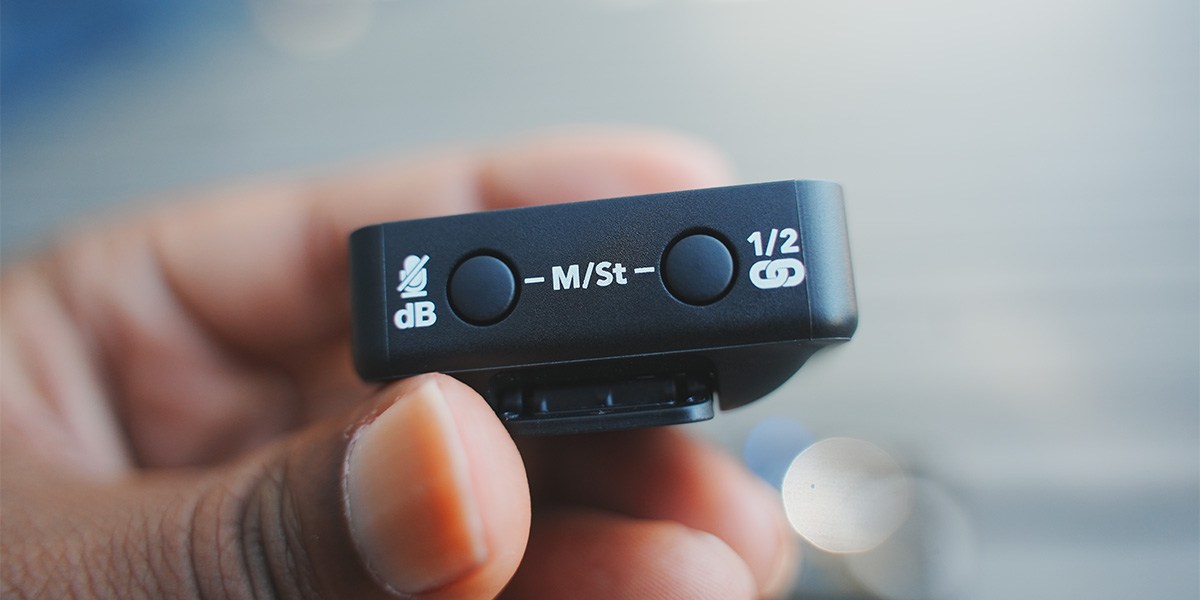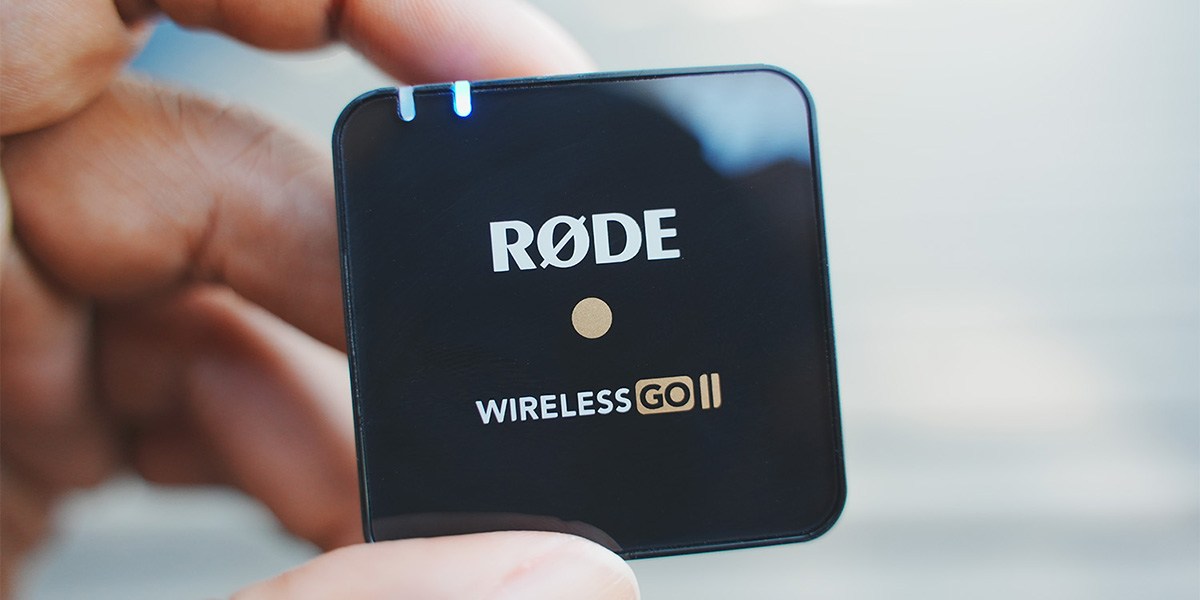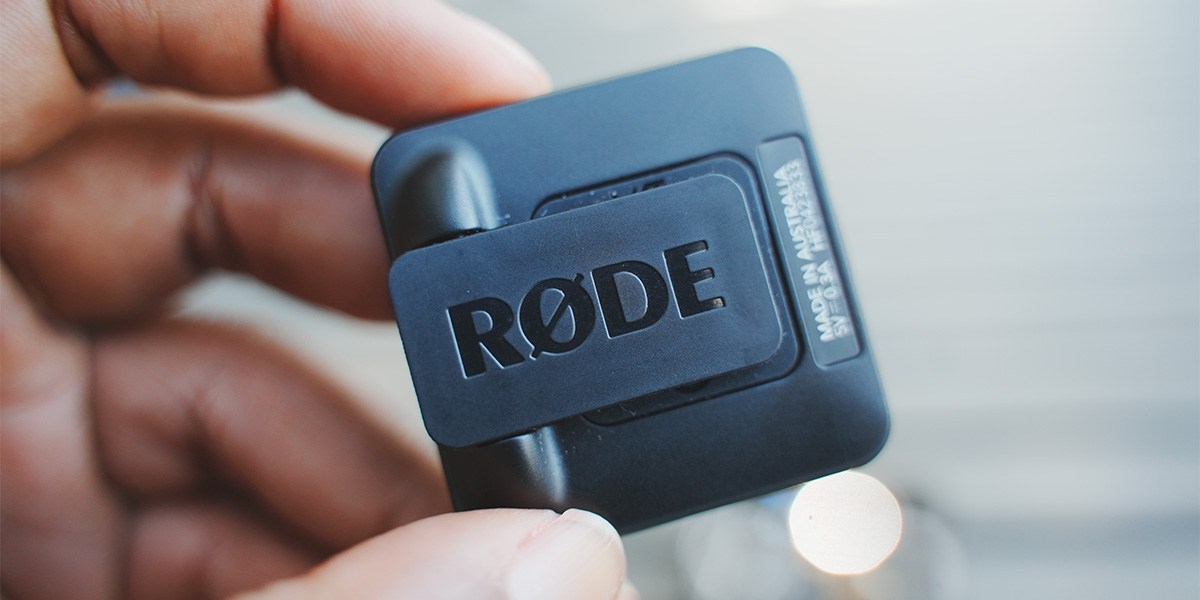Rode
Wireless Go II
- Bottom Line
-
If you can’t get enough of customizable options and plenty of mic settings and features to play with, the Rode Wireless Go II is your best bet. It even needs a companion app to cover everything it’s capable of.
- Pros
-
The Rode brand name is synonymous with quality. We never had issues with audio quality tests in both indoor and outdoor environments. It boasts 40 hours of onboard recording, a dual channel feature and a 656-foot range. It comes fully compatible with the Rode Connect podcasting and streaming software to give you more versatility for YouTube.
- Cons
-
The biggest drawback is its price point, making it much more expensive than its competitors. We also found the companion app to be confusing and the user manual unhelpful.
About the product
We tested the Rode Wireless Go II to see if it’s worth it
Audio quality is paramount in the world of content creation. In fact, some may say it's more important than video. That's why we took a close look at the Rode Wireless Go II, a tried-and-tested wireless microphone system long renowned by both professional and amateur content creators for its portability and high-quality audio capture.
Designed to be both compact and versatile, Rode's flagship system promises professional-grade features in a user-friendly package. But does it deliver on these promises? After we put it through a series of rigorous tests in the BestReviews Testing Lab to find out, we determined that there is indeed plenty to love for professionals as well as ambitious beginners, who will appreciate the advanced features as their skills improve.
What is the Rode Wireless Go II?
Product specifications
Polar Pattern: Omnidirectional | Frequency Response: 50 Hz to 20 kHz | Connector: USB-C, TRS and TRRS | Dimensions: 1.73” W x 0.72” D x 1.79” H | Weight: 1.1 oz | Material: High-quality plastic | Accessories: 2 fur windshields, 2 USB-C cables, 1 SC5 3.5-millimeter TRS cable and 1 carry pouch
The Rode Wireless Go II is a wireless microphone system designed to offer high-quality audio capture in a portable form factor. Rode primarily aims for content creators, journalists and videographers who need a reliable audio system on the move. It's comparable to market leaders like the DJI Mic (for which it helped pave the way) but stands out for its pro-grade feature set and no-frills recording interface.
In terms of specifications, the Rode Wireless Go II comes with an omnidirectional polar pattern and a frequency response ranging from 50 hertz to 20 kilohertz. The system includes various connectors such as USB-C and TRS, making it versatile for different setups. It's lightweight, with a durable plastic build weighing just 31 grams.
Pros
- Excellent sound quality
- User-friendly interface
- Multiple audio transfer options
Cons
- Thin travel case
- Requires app for advanced settings
Testing the Rode Wireless Go II
Our testing process helps us judge the microphone's performance across a variety of conditions. The first phase involves a two-minute recording in an outdoor setting. We chose this environment to assess how well the Rode Wireless Go II handles ambient noise, including factors like traffic and wind. This helps us determine the system's ability to isolate the subject's voice from background noise, a crucial feature for outdoor interviews or on-the-go reporting.
The second phase of testing takes place in an indoor setting with controlled acoustics. We selected this environment to evaluate the system's performance in a more predictable soundscape. Here, we focus on the microphone's sensitivity, its ability to capture sound from multiple directions due to its omnidirectional polar pattern, and its overall audio clarity. This phase simulates conditions like studio interviews or video podcast recording, where you have more control over the acoustics, but may also be contending with minor noise from, say, a computer's fan.
The third and final phase involves technical testing to explore the system's additional features, including wireless simul-recording of two subjects, direct-to-device recording (camera, phone or onboard storage) and the system's range.
Rode Wireless Go II price and where to buy
The Rode Wireless Go II is available for $299 at Amazon and $300 at Best Buy.
Rode Wireless Go II setup and ease of use
Please ensure it is compressed before being added to the page—less than 1 MB. If we didn’t test this product or didn’t get custom photos, use the Amazon photo.
Setting up the Rode Wireless Go II is generally straightforward when recording to an external device. The system comes with a quick-start guide that walks you through the initial setup process, which involves turning on the transmitter and receiver to pair them. The devices automatically recognize each other, eliminating the need for manual pairing. Setup is a cinch for those who may not be tech-savvy and want a plug-and-play solution for their audio needs.
Accessing some of the microphone's more advanced features requires PC and smartphone apps. For instance, you can only access the onboard recordings using Rode's PC app, and because the file types are proprietary, you may need to convert them before using them in your preferred workflow. This adds extra steps and complicates things unnecessarily. Otherwise, all of the essentials are available as soon as you power on and connect the system to your recording device.
Transmitter and receiver
The transmitter and receiver of the Rode Wireless Go II are designed to pair effortlessly, providing a seamless user experience right out of the box. Once powered on, the devices automatically recognize each other and establish a secure connection.
The transmitter comes equipped with a built-in microphone and also offers the option to connect an external lavalier mic. The device features a clip-on design for easy attachment to clothing or camera rigs. They also allow up to 40 hours of onboard backup recording each, which is helpful for professional jobs where redundancy is paramount.
The receiver provides an LCD interface that serves as the control center for the system. This display provides real-time monitoring of various metrics, such as signal strength, audio levels and battery life. You can make on-the-fly gain and channel adjustments using the physical buttons situated on the sides of the receiver.
Sound quality
One of Rode's pillar promises is quality sound engineered to handle any recording environment, and we can safely say the Wireless Go II system delivers on that. The system uses Rode's Series IV 2.4-gigahertz digital transmission, which is said to minimize the risk of interference or distortion. While our testing environment didn't produce the extreme circumstances that would challenge that claim, we can confirm its effectiveness in a typical usage scenario. The built-in microphone on the transmitter has an omnidirectional polar pattern, which is effective in capturing sound at consistent quality from multiple directions. This makes it versatile for different recording scenarios, whether it's a one-on-one interview or a multiperson discussion.
We found it adequately picked up and carried voices at moderate distances, with a nice warm sound signature that helps emphasize spoken-word recording. The resulting audio is true to life, ensuring the unique quirks of your voice box come through in the recording.
However, while the system excels with audio clarity, its natural noise cancellation capabilities are starting to lag behind the competition. The Rode Wireless Go II does a reasonable job of isolating the subject's voice from moderate background noise, but it struggles to separate high-frequency sounds from sources like traffic or machinery. This is particularly noticeable in outdoor settings or noisy environments. This isn't a deal-breaker, though, and you can easily correct it in post-production with proper gain control.
Settings and features
The Rode Wireless Go II offers a range of settings, most of which you can easily access using physical buttons and the LCD interface on the receiver. Basic indicators for audio levels, signal strength and battery life are readily available, providing a user-friendly experience even for those who may not be well-versed in audio equipment. The LCD interface is intuitive, with icons and text that are easy to understand, making it simple for users to make quick adjustments during a recording session. This is particularly useful in dynamic recording environments where conditions can change rapidly.
For users looking to take advantage of the system's more advanced features, the Rode smartphone app is a necessary companion. The app offers a deeper level of customization, including the ability to adjust gain settings, switch between mono and stereo modes, enable mic pads via low-sensitivity mode and even access a high-pass filter to reduce low-frequency noise. However, this reliance on the app for advanced settings could be considered a drawback for some users. It requires a separate device for setup and adjustments, which may not be convenient for everyone, especially those who prefer a more straightforward, standalone system.
Wireless Go vs. Wireless Go II
The Rode Wireless Go II builds upon the foundation laid by its predecessor with notable improvements like onboard recording. This feature allows for greater flexibility in post-production, as you can process your audio track separately in your preferred editor before easily syncing it with your video footage. It's also nice insurance against potential failure in your external recording device.
Another significant upgrade is the extended transmission range. While the original Wireless Go's Series III wireless system offered a respectable 70-meter range, the Series IV radio inside the Wireless Go II takes it a step further with a maximum range of up to 200 meters. Lastly, the three-stage pad is expandable to 10 stages for more granular gain control.
Rode Wireless Go II benefits
Although it's a little long in the tooth compared to younger contemporaries, the Rode Wireless Go II stands its ground in 2023 as a reliable audio system that offers excellent sound quality, making it a solid choice for both beginners and professionals. The LCD display on the receiver offers an intuitive user interface for real-time monitoring of various recording metrics.
The Wireless Go II is also incredibly versatile. With its multiple audio transfer options and the ability to record directly to a camera, recording device, phone (including Lightning-based iPhones) or onboard storage, the Rode Wireless Go II is still one of the most flexible wireless recording systems available. Its extended transmission range of up to 200 meters makes it ideal for a variety of recording scenarios, from indoor interviews to outdoor events.
Rode Wireless Go II drawbacks
While the Rode Wireless Go II excels in many areas, it does have some drawbacks that potential users should consider. One such issue is the travel case it comes with, which offers limited protection and storage space for the device and its accessories. The case lacks dedicated compartments, making it less organized and potentially leading to wear and tear on the equipment during travel. This could be a significant concern for those who frequently move around with their gear.
Another drawback is the system's dependency on smartphone and PC apps for accessing its advanced features. While the app offers a range of customization options, it requires a separate device for some minor adjustments, as well as accessing onboard recordings. This could be inconvenient for users who prefer a more straightforward, standalone system. The need to use a computer for certain settings adjustments could also be frustrating, particularly for those who may need to make immediate adjustments during fieldwork.
The cryptic, one-page pictographic instructions included with the Rode Wireless Go II don't help much. You'll likely require further independent research to learn how to unlock its full capabilities.
Should you get the Rode Wireless Go II?
The Rode Wireless Go II is a great wireless audio system for those who want flexibility and reliability in a system that finely balances affordability, usability and quality. The system's dated design and busy user interface would initially intimidate newcomers, but navigating the basics becomes intuitive fairly quickly. Accessing some of its advanced features might be another story depending on your technical proficiency, as that requires some annoying app trickery.
Onboard recording is the biggest benefit locked behind Rode's unnecessary proprietary wall, and the company doesn't make it painfully clear to how to scale it for those who aren't technically inclined. But if you search up a five-minute YouTube tutorial, you'll settle in quicker than you think. We'd recommend the Rode Wireless Go II to any serious content creators who are looking for a robust system they can grow into as their needs increase.












